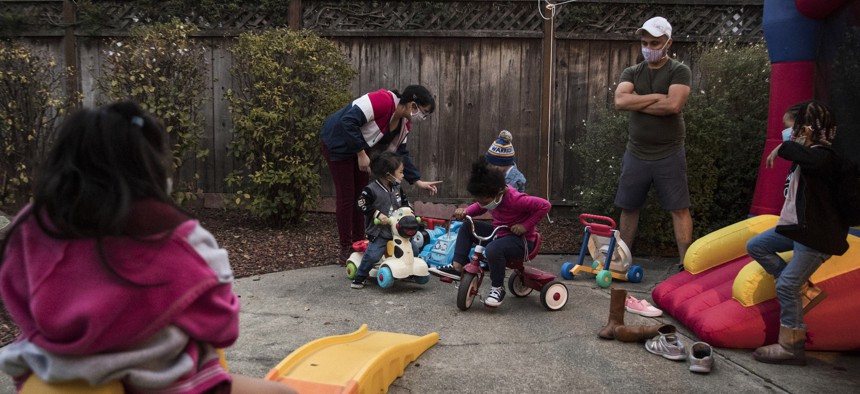How One State Is Tackling Child Care Challenges

Carlos Avila Gonzalez/The San Francisco Chronicle via Getty Images
Like much of the country, Michigan is navigating a shortage of child care providers. But federal funds, paired with efficient coordination between state agencies, has helped support hundreds of new providers in just one year.
As the school year draws to a close, many parents around the country are struggling to figure out who will care for their children during the workweek. It’s a challenge that’s become a crisis over the last few years as child care workers have left the industry in droves, and states have scrambled to fill the void.
Since February 2020, more than 90,000 providers have left their jobs, according to the Center for American Progress. Today, just over half of all children in the United States live in a child care desert, meaning there aren’t enough daycare spaces to accommodate all children in an area.
The shortage affects the wider economy as many parents are forced to choose between working and staying home with their kids. States looking for some solutions may look to Michigan for ideas—a state initiative is seeing encouraging results after just one year.
According to an analysis last year by the Detroit Free Press, Michigan has more than 559,000 children under the age of 5 but only about 264,000 child care “slots” available. Between February 2020 and August 2022, the number of child care providers statewide dropped 7%.
To address that gap, Michigan launched its Caring for MI Future initiative one year ago with the goal of opening 1,000 new child care programs by the end of 2024. The state is using $100 million in federal Child Care and Development Block Grant funds to support entrepreneurs and existing providers by contributing startup funding, facility improvement grants, and business development tools including workshops and webinars.
To date, the Michigan initiative helped launch nearly 700 new programs and expanded more than 1,800 existing ones, increasing statewide child care capacity by 25,000 spots, according to the state Department of Licensing and Regulatory Affairs.
Once licensed, providers can also enroll in the state’s child care subsidy program that seeks to encourage centers to take more children from low-income families.
But an increase in the number of child care centers doesn’t necessarily mean families will find accommodations more easily, said Cindy Lehnhoff, director of the National Child Care Association. In Michigan, there needs to be one staff member for every six children in a licensed child care center, and in September nearly 90% of providers in Michigan reported hiring challenges.
Recruiting and retaining child care workers is a challenge for states nationwide, in part because jobs in child care are low paying with a national average of about $14 an hour. With public schools in desperate need of more teachers, many people who have previously worked in child care or are interested in early childhood education careers are considering teaching, enticed by summers off and better pay.
Child care employment is still down about 5% compared to pre-pandemic levels, but is trending upward.
Staffing is less of a problem for family child care facilities, which are typically smaller than traditional child care centers and are located in a person’s home.
While the number of home-based programs remains about 10% below pre-pandemic levels, they are critical in addressing the child care crisis, Lehnhoff said. They generally require smaller staffs and running one can be less expensive than other centers. Families living in rural communities—which are more at risk of being care deserts—are also more likely to rely on home-based child care services.
The Caring for MI Future initiative aims to address some of these challenges by providing grant funding to 42 counties for workforce development efforts to hire, train and keep child care workers employed in their local communities.
While it faces its own share of challenges, Michigan is one of the top states in terms of spending efficiency for early childhood education programs.
In 2018, after Congress expressed concern over how efficiently states were spending early childhood funding, the Bipartisan Policy Center published a report ranking states based on fund management. The study took into account factors like how many agencies are involved in administering early childhood education funding and the total amount in state and federal dollars directed to such programs.
In that initial report, Michigan ranked No. 22. In an updated report published earlier this year, the state jumped to No. 5 and was highlighted among a handful of other states for making “exceptional progress.”
Driving that jump was Whitmer’s decision to draw out all funds available to Michigan through the American Rescue Plan Act, something not all governors chose to do, Lehnhoff said. Many providers used the federal funding to help cover staffing and operating costs.
Coordination between different state offices was also an important factor.
“[Gov. Whitmer] had a plan and she partnered with agencies, pulled them together and everybody knows that you get a lot more from collaboration and partnership,” Lehnhoff said.
One of those important partnerships was with the Michigan Departments of Education and Licensing and Regulatory Affairs, a collaboration that could lead to better data collection practices, Lehnhoff said.
“Data for child care is still an emerging science … that is one of the things that I think has hindered us throughout time is the data and keeping data,” Lehnhoff said, adding that during the pandemic there was more federal funding made available to help address those gaps.
Editor’s Note, May 31, 2023: This story was updated to include additional information about Michigan’s child care initiative, specifically how much the program increased statewide capacity and details about its child care subsidy.
Molly Bolan is the assistant editor for Route Fifty.
NEXT STORY: Why More Cities Are Hiring ‘Night Mayors’ and Establishing Forms of Nighttime Governance






